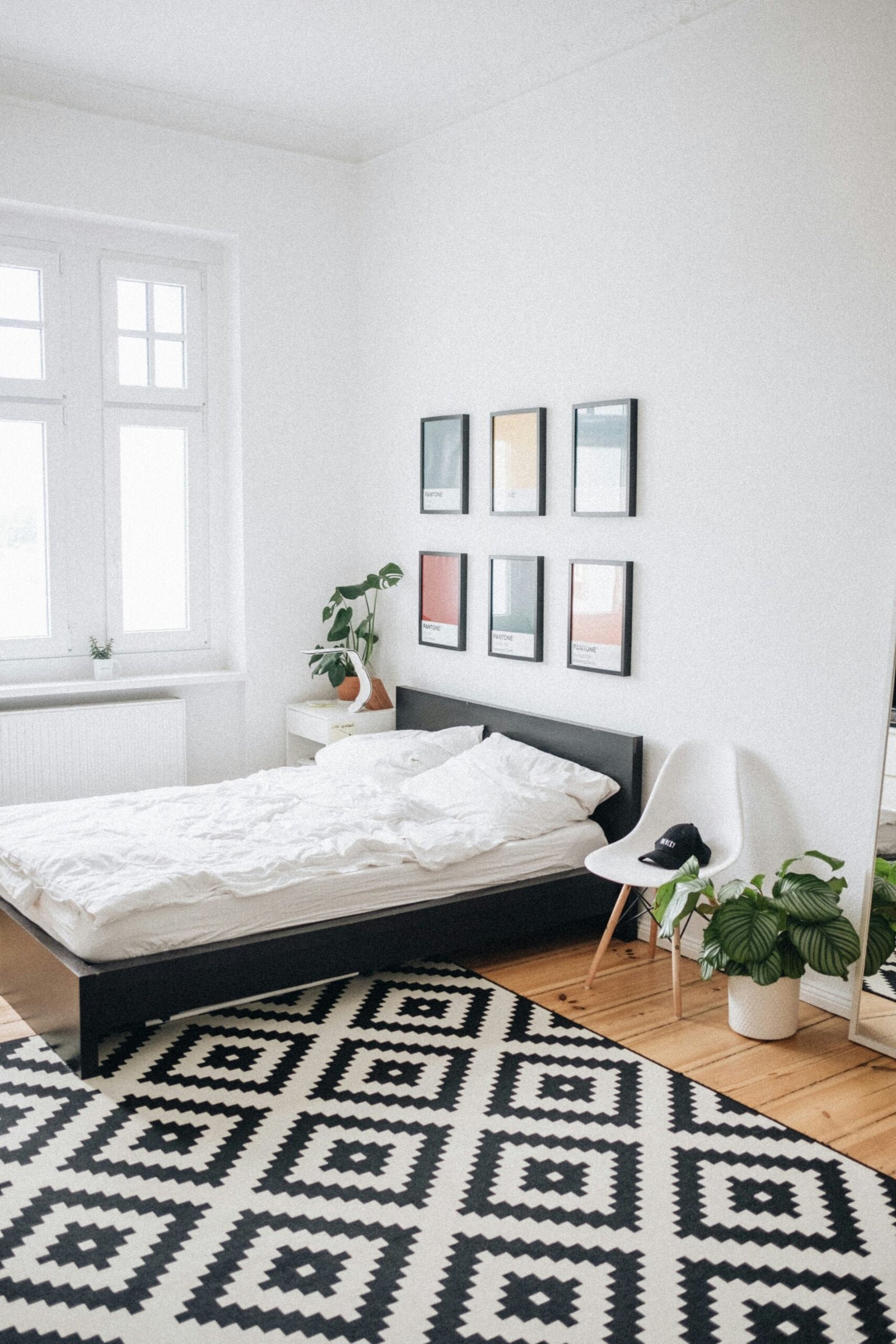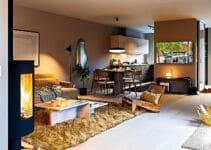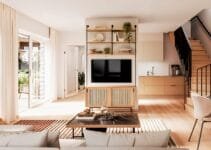Discover practical tips and design strategies to transform your studio apartment into a cohesive, functional, and stylish living space. Learn how to define zones, choose a consistent color palette, maximize vertical space, incorporate multi-functional furniture, use mirrors and lighting effectively, control clutter, and personalize your space. Achieve a harmonious layout that maximizes both space and functionality in your small apartment.
Studio apartment living – Blend of challenges and advantages
Studio apartment living presents a unique blend of challenges and advantages. On one hand, the compact nature of a studio apartment encourages a minimalist lifestyle, making it easier to maintain and manage. However, the limited space can also pose significant hurdles in terms of functionality and aesthetic appeal. Without a thoughtful approach to layout and design, a studio apartment can quickly feel cramped and disorganized.

Creating a cohesive layout is paramount to maximizing the potential of your studio apartment. A well-designed space can seamlessly integrate various functional areas—such as sleeping, dining, and working zones—into a harmonious whole. This not only makes the apartment more comfortable and efficient but also enhances its visual appeal.
Please read our article watch the newly uploaded video from our YouTube channel:
“Grig Stamate – Interior Design Solutions”
https://www.youtube.com/@GrigStamate
How to Make Your STUDIO APARTMENT Layout Cohesive (video)
Here, you can see other related videos from our channel:
‘Small but BEAUTIFUL and COMFY’ – 40 Studio Apartment Design Ideas (video)
Maximizing Space: A LOFTED STUDIO APARTMENT Tour (video)
In this blog, we will delve into practical tips and design strategies aimed at helping you achieve a cohesive and balanced living environment in your studio apartment. From smart furniture choices and clever storage solutions to the strategic use of color and lighting, we will explore a range of techniques that can transform your small space into a stylish and functional home.
Defining Zones for Different Functions
Creating a cohesive layout in a studio apartment hinges on the effective use of zoning. Zoning allows you to delineate areas for different activities such as sleeping, eating, working, and relaxing without resorting to permanent walls. This strategy not only maximizes space but also ensures each area is functional and aesthetically pleasing.
To establish a sleeping zone, consider placing your bed in a corner or against a wall furthest from the entrance. This placement creates a sense of privacy and separation from the other areas. Using a room divider, such as a bookshelf or a decorative screen, can further enhance this separation without closing off the space completely. A canopy bed or a curtain can also serve as a stylish partition, adding both functionality and visual interest.
The eating area can be defined by situating a dining table and chairs near the kitchen or adjacent to a window to capitalize on natural light. A strategically placed rug beneath the dining table can demarcate this zone, providing a visual boundary that distinguishes it from the living or working areas. Opt for furniture that is proportional to the space, such as a compact dining set or bar stools at a kitchen counter, to maintain an open and airy feel.
For a working zone, utilize a corner or a wall near a source of natural light to set up a desk and an ergonomic chair. Floating shelves or a compact bookshelf can provide additional storage without encroaching on valuable floor space. Ensure that this zone is well-lit with a desk lamp to create a conducive work environment. Personal touches like wall art or plants can enhance the ambience and productivity of this area.
The relaxing zone is often the heart of a studio apartment and can be defined by arranging seating like a sofa or a couple of armchairs around a central coffee table. Use a large area rug to anchor the space and add a sense of coziness. Positioning the seating near a window or a focal point like a television or a piece of artwork can create a welcoming and comfortable atmosphere.
By thoughtfully arranging furniture, using rugs, and incorporating room dividers, you can effectively create distinct functional zones within your studio apartment. This approach ensures a cohesive layout that maximizes both space and functionality, transforming a small area into a versatile and harmonious living space.
Choosing a Consistent Color Palette
Creating a cohesive color palette is foundational to unifying the layout of a studio apartment. A thoughtfully selected color scheme can significantly enhance the perception of space, making the apartment feel more expansive and harmonious. It is essential to choose colors that not only complement each other but also work harmoniously with the overall design and function of the apartment.
Begin with a neutral base color for the walls and larger pieces of furniture. Shades of white, beige, and light gray are excellent choices as they create a clean, timeless backdrop that can easily accommodate various styles and accessories. Neutrals have the added benefit of reflecting light, which can help make the space feel brighter and larger.
Once you have established your neutral base, incorporate accent colors to add interest and personality to the apartment. Accent colors can be introduced through smaller items such as cushions, rugs, artwork, and decorative pieces. When selecting these accent colors, consider hues that evoke the atmosphere you want to create—soft pastels for a calming effect, vibrant shades for energy, or earthy tones for a grounded, natural feel.
To ensure a balanced and cohesive look, limit your palette to three to five colors. This includes one or two neutrals and two or three accent colors. Using too many colors can make the space feel chaotic and cluttered, whereas a limited palette maintains a unified and sophisticated appearance. Additionally, ensure that these colors flow seamlessly from one area of the studio to another, creating a visual connection that ties the entire apartment together.
Incorporating patterns and textures within your chosen color palette can also add depth and interest without overwhelming the space. For instance, a neutral sofa with a textured throw or patterned cushions can introduce subtle complexity while keeping the overall look cohesive. By carefully selecting and combining colors, you can create a studio apartment that is both stylish and harmonious.
Maximizing Vertical Space
In a studio apartment, maximizing vertical space is crucial for creating a cohesive and functional living environment. By effectively utilizing the room’s height, you can significantly increase storage options and maintain an open and airy feel in your compact living quarters.
One of the primary strategies for maximizing vertical space is to incorporate tall shelving units. These units can be placed against walls to provide ample storage without encroaching on valuable floor space. Tall bookshelves, for instance, can hold books, decorative items, and even kitchen supplies, making them versatile and practical additions. Additionally, opting for open shelving can contribute to a feeling of openness and prevent the room from feeling cluttered.
Hanging storage solutions are another effective way to utilize vertical space. Wall-mounted racks, hooks, and pegboards can be used to store everyday items such as kitchen utensils, accessories, and tools. This approach not only keeps items within easy reach but also frees up countertops and other surfaces. In the kitchen, consider installing a pot rack or magnetic knife strip to keep cooking essentials organized and accessible.
Lofted beds are an excellent solution for studio apartments, as they elevate the sleeping area and create additional space underneath. This space can be used for a variety of purposes, such as a home office, seating area, or extra storage. By lifting the bed off the ground, you effectively double the usable space in your apartment, making it easier to maintain a cohesive layout.
Keeping the floor area clear is essential to achieving an open and airy feel in a studio apartment. By focusing on vertical storage solutions, you can reduce clutter and make the most of your limited space. This approach not only enhances the functionality of your apartment but also contributes to a more organized and visually appealing living environment.
Incorporating Multi-Functional Furniture
In a studio apartment, space is at a premium. Utilizing multi-functional furniture is a strategic way to maximize the limited area available while maintaining both functionality and comfort. The key to a cohesive layout lies in selecting pieces that serve multiple purposes without overwhelming the room.
One prime example of multi-functional furniture is the sofa bed. By day, it serves as a comfortable seating area for you and your guests. By night, it effortlessly transforms into a bed, eliminating the need for a separate sleeping area. This dual-purpose piece is particularly beneficial in studio apartments where every square foot counts.
Another versatile option is the fold-out table. These tables can be used as dining surfaces, workstations, or even as extra counter space in the kitchen. When not in use, they can be folded and stored away, freeing up valuable floor space. This flexibility makes fold-out tables an excellent choice for those looking to maintain an open and airy feel in a small apartment.
Storage ottomans are also invaluable in a studio setting. They provide a place to sit, function as a coffee table, and offer hidden storage for items like blankets, books, or other miscellaneous items. The added storage helps to keep the apartment organized and clutter-free, which is essential for creating a cohesive and inviting living space.
Incorporating multi-functional furniture allows you to make the most of your studio apartment. By selecting pieces that offer more than one use, you can save space while still enjoying the comfort and functionality of a larger living area. Thoughtfully integrating these versatile items into your layout can significantly enhance the overall cohesiveness and livability of your compact home.
Using Mirrors and Lighting to Enhance Space
Maximizing the perceived space in a studio apartment is crucial for creating a comfortable and inviting environment. Two effective tools to achieve this are the strategic use of mirrors and lighting. By thoughtfully incorporating these elements, you can make a small area appear more expansive and cohesive.
Mirrors play a pivotal role in visually enlarging a room. Placing a large mirror opposite a window can reflect natural light, thereby brightening the space and giving the illusion of depth. Similarly, positioning mirrors on walls adjacent to light sources can amplify both natural and artificial light, contributing to a more open and airy ambiance. Consider using mirrored furniture or decorative wall mirrors as additional design elements that serve both functional and aesthetic purposes.
Lighting is another essential aspect of enhancing a studio apartment’s layout. A well-planned lighting scheme can transform your space, making it feel larger and more welcoming. Begin with ambient lighting, which provides overall illumination. Ceiling fixtures, such as chandeliers or recessed lights, are excellent choices for this purpose. Next, integrate task lighting to focus on specific areas, such as reading nooks or kitchen counters. Table lamps, floor lamps, and under-cabinet lights are practical options that also contribute to the room’s style.
Accent lighting adds dimension and highlights architectural features or décor. Wall sconces, LED strip lights, and spotlights can be used to draw attention to artwork, plants, or unique design elements, creating a layered and dynamic lighting environment. Combining these three types of lighting—ambient, task, and accent—ensures a balanced and versatile illumination scheme.
Incorporating mirrors and a diverse lighting strategy can significantly enhance the functionality and aesthetics of a studio apartment. Through careful placement and selection, these elements can create a cohesive, spacious, and inviting living area that defies its physical limitations.
Keeping Clutter Under Control
Maintaining a clutter-free environment is essential for creating a cohesive layout in a studio apartment. Given the limited space, clutter can quickly make the area feel cramped and disorganized. To avoid this, it’s important to regularly purge unnecessary items. Begin by assessing each item in your apartment and ask yourself whether it serves a purpose or brings you joy. If the answer is no, consider donating, selling, or recycling it. Regularly scheduling decluttering sessions can help keep the accumulation of items in check.
Utilizing hidden storage solutions is another effective strategy for keeping clutter at bay. Opt for furniture pieces that offer built-in storage, such as ottomans with compartments, beds with drawers underneath, or multi-functional shelving units. These options allow you to store belongings out of sight, ensuring that your living space remains tidy and visually appealing. Additionally, consider using vertical space by installing shelves or wall-mounted storage to maximize the available area without encroaching on valuable floor space.
The psychological benefits of a tidy and organized space should not be underestimated. A clutter-free environment can reduce stress, increase productivity, and promote a sense of calm. In a studio apartment, where living, sleeping, and working areas often overlap, it’s particularly important to maintain a clear and organized layout. By keeping clutter under control, you create a more functional and inviting space that supports your daily activities and overall well-being.
Incorporating these practical tips into your routine can significantly enhance the cohesiveness of your studio apartment layout. Regularly purging items and utilizing hidden storage solutions are key strategies for maintaining an organized and clutter-free environment, ultimately contributing to a more harmonious and enjoyable living space.
Personalizing Your Space
Making a studio apartment feel like home involves incorporating personal touches that reflect your individual style and personality. One effective way to achieve this is through the strategic use of artwork. Choose pieces that resonate with you, whether they are paintings, photographs, or prints. Displaying art on your walls can add color and character to the space, making it uniquely yours.
Plants are another excellent way to personalize your studio apartment. Not only do they bring a touch of nature indoors, but they also contribute to a sense of tranquility and well-being. Consider incorporating a variety of plants, from small succulents to larger potted trees, to add depth and texture to your living space. Additionally, plants can be used as natural dividers to delineate different areas within your studio.
Decorative elements such as throw pillows, rugs, and curtains also play a significant role in personalizing your apartment. Opt for patterns and colors that complement your overall design scheme while reflecting your personal taste. These items can easily be swapped out or updated, allowing you to refresh your space without a major overhaul.
While personalization is important, it is equally crucial to maintain a cohesive look throughout your studio apartment. Aim for a balance between individual expression and overall harmony. This can be achieved by sticking to a consistent color palette and style theme. For instance, if your decor leans towards a minimalist aesthetic, ensure that your personal touches align with this theme to avoid visual clutter.
In summary, personalizing your studio apartment is about finding the right balance between self-expression and cohesiveness. By thoughtfully incorporating artwork, plants, and decor that resonate with you, you can create a space that is both functional and reflective of your unique personality.
Other related posts from our website:
Let’s see here, three of them:
https://howtobuildahouseblog.com/well-designed-studio-apartments-tips-and-ideas/
https://howtobuildahouseblog.com/big-design-ideas-for-small-studio-apartments-3/
https://howtobuildahouseblog.com/big-design-ideas-for-small-studio-apartments-2/
We also sincerely hope you like our ideas from this post, and you have also enjoyed our uploaded YouTube video.
See you next time at another article.
Thank you so much for your time. Bye now!


